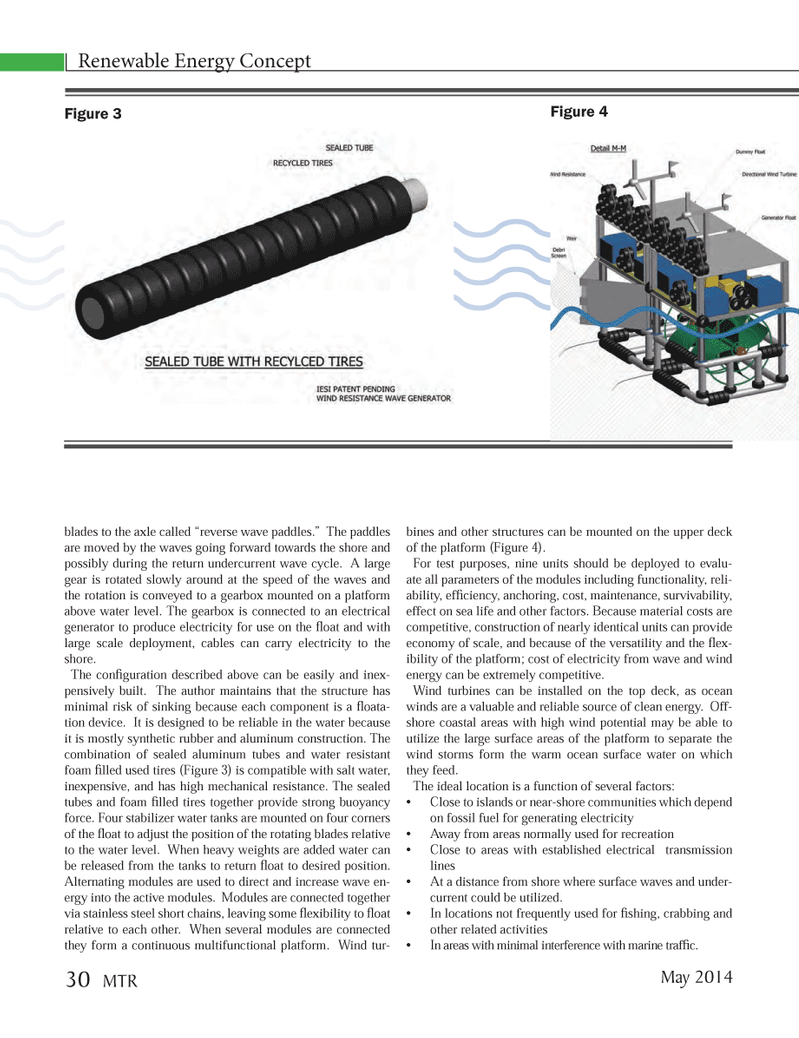
Page 30: of Marine Technology Magazine (May 2014)
AUV Operations
Read this page in Pdf, Flash or Html5 edition of May 2014 Marine Technology Magazine
Renewable Energy Concept blades to the axle called ?reverse wave paddles.? The paddles are moved by the waves going forward towards the shore and possibly during the return undercurrent wave cycle. A large gear is rotated slowly around at the speed of the waves and the rotation is conveyed to a gearbox mounted on a platform above water level. The gearbox is connected to an electrical generator to produce electricity for use on the oat and with large scale deployment, cables can carry electricity to the shore.The con guration described above can be easily and inex- pensively built. The author maintains that the structure has minimal risk of sinking because each component is a oata-tion device. It is designed to be reliable in the water because it is mostly synthetic rubber and aluminum construction. The combination of sealed aluminum tubes and water resistant foam lled used tires (Figure 3) is compatible with salt water, inexpensive, and has high mechanical resistance. The sealed tubes and foam lled tires together provide strong buoyancy force. Four stabilizer water tanks are mounted on four corners of the oat to adjust the position of the rotating blades relative to the water level. When heavy weights are added water can be released from the tanks to return oat to desired position. Alternating modules are used to direct and increase wave en- ergy into the active modules. Modules are connected together via stainless steel short chains, leaving some exibility to oat relative to each other. When several modules are connected they form a continuous multifunctional platform. Wind tur- bines and other structures can be mounted on the upper deck of the platform (Figure 4).For test purposes, nine units should be deployed to evalu- ate all parameters of the modules including functionality, reli- ability, ef ciency, anchoring, cost, maintenance, survivability, effect on sea life and other factors. Because material costs are competitive, construction of nearly identical units can provide economy of scale, and because of the versatility and the ex- ibility of the platform; cost of electricity from wave and wind energy can be extremely competitive. Wind turbines can be installed on the top deck, as ocean winds are a valuable and reliable source of clean energy. Off- shore coastal areas with high wind potential may be able to utilize the large surface areas of the platform to separate the wind storms form the warm ocean surface water on which they feed. The ideal location is a function of several factors: Close to islands or near-shore communities which depend on fossil fuel for generating electricity Away from areas normally used for recreation Close to areas with established electrical transmission lines At a distance from shore where surface waves and under- current could be utilized. In locations not frequently used for shing, crabbing and other related activities In areas with minimal interference with marine traf c.Figure 3Figure 430 MTRMay 2014MTR #4 (18-33).indd 30MTR #4 (18-33).indd 305/13/2014 9:59:51 AM5/13/2014 9:59:51 AM

 29
29

 31
31
